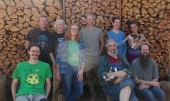
 1
1
















John Polk wrote:
the brown, barren line that runs from the center of the bottom of that Google map, NW to the left edge of the map is the San Andreas fault!
John Polk wrote:Soils and water in the region are highly alkaline (it all drains to Soda Lake!). Trees are scarce, but it is one of the largest reserves of native grasses in California. And yes, it is one of the best places in the western US to observe spring wild flowers (if the weather is dry enough to allow passage on the Soda Lake Road).
John Polk wrote:The area is also home to a dozen endangered species. Development is highly restricted in the region...which makes it ideal for a permaculture establishment.
 There will be two plants that both of them individually are the largest array in the world. We'll see how that goes after the first one gets installed. They will be very close to this site. But, like I said the owner had plans for this site and got turned down and he wants to find another site for those plans in another county altogether. For that I don't blame him at all. I personally am in love with the land out there. Quite honestly it is one of the only places that makes me feel so comfortable. It is so quiet. You can hear cars miles away out there. You can have your own thoughts and the rest of the world just seems to disappear, out of mind, gone forever. And it's quite beautiful too, even in the heat of summer. One of the sunniest places in USA, it has a sky so big, the folks in Montana raise an eyebrow! Anyway, I do agree with the ideal for permaculture aspect. There are other farmers in the area, and the only thing they grow is hay/oats/barley. Then there's La Panza Ranch that went grape and now is a wine producer. All those endeavors are monoculture, and either expensive or not profitable. Permaculture can offer a more realistic use of the land and offer the greatest return on investment.
There will be two plants that both of them individually are the largest array in the world. We'll see how that goes after the first one gets installed. They will be very close to this site. But, like I said the owner had plans for this site and got turned down and he wants to find another site for those plans in another county altogether. For that I don't blame him at all. I personally am in love with the land out there. Quite honestly it is one of the only places that makes me feel so comfortable. It is so quiet. You can hear cars miles away out there. You can have your own thoughts and the rest of the world just seems to disappear, out of mind, gone forever. And it's quite beautiful too, even in the heat of summer. One of the sunniest places in USA, it has a sky so big, the folks in Montana raise an eyebrow! Anyway, I do agree with the ideal for permaculture aspect. There are other farmers in the area, and the only thing they grow is hay/oats/barley. Then there's La Panza Ranch that went grape and now is a wine producer. All those endeavors are monoculture, and either expensive or not profitable. Permaculture can offer a more realistic use of the land and offer the greatest return on investment.



Jonathan_Byron wrote:
Rainfall less than 10 inches per year - that puts you in the desert zone. You can grow other things if your plan includes water harvesting (and probably lots of Earthwork initially). But the mainstay should be modeled on a desert ecosystem.
Jonathan_Byron wrote:Ordinary filters cannot remove salt from water - you will need to do reverse osmosis, distillation, or some heavy duty chemical processes (like ion exchange resins) ... might be practical for drinking water, but for irrigation, it would be very expensive.








jacque g wrote:
These folks are not real far from you - http://www.quailsprings.org/ - and Santa Barbara has a very active permie network. Since you have special soils and special plants, it would be good to get in touch with people who have specific local knowledge.

|
If tomatoes are a fruit, then ketchup must be a jam. Taste this tiny ad:
The new purple deck of permaculture playing cards
https://www.kickstarter.com/projects/paulwheaton/garden-cards
|




